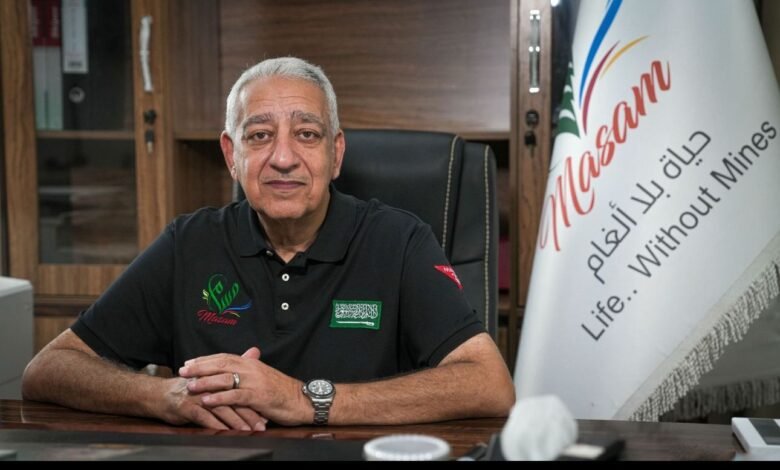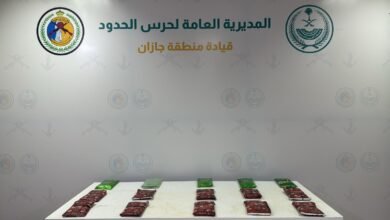The Houthi militias exploit every truce to lay additional landmines across Yemeni territory.

Mr. Ousama Algosaibi, Managing Director of the Masam Landmine Clearance Project -Yemen, stated that Masam is a fully Saudi initiative. It began as a concept in late 2017, with operations officially launching in mid-2018. Today, the project spans most of the liberated areas in Yemen, including Al-Jawf, Marib, Shabwa, Bayhan, Usaylan, Aden, and the entire west coast down to the south of Hodeidah.
The Masam Project currently operates with 32 demining teams, supported by two special task teams. As one of Saudi Arabia’s humanitarian initiatives in Yemen, the project functions under the umbrella of the King Salman Humanitarian Aid and Relief Center (KSrelief) and employs 550 personnel working on the ground across the country.
In a Skype interview on the “This is Riyadh” program hosted by journalist Khaled Al-Owaid on the Saudi Al Ekhbariya channel, Algosaibi highlighted the project’s significant achievements. To date, Masam has successfully removed over 492,000 landmines, explosive devices, and unexploded ordnance from Yemeni territory. He emphasized that this figure represents a major accomplishment by both local and international standards.
Algosaibi also noted that while the project focuses exclusively on liberated areas—avoiding frontlines and active conflict zones—numerous reports indicate the presence of large quantities of mines in those contested regions. Much work remains to ensure the safety and security of civilians across Yemen.
The Managing Director of the Masam Project confirmed that Houthi militias continue to exploit periods of truce to plant additional landmines. He stated, “We are in a constant race with the Houthi militias—we clear mines from one side while they plant more on the other.”
He highlighted the situation in Shabwa, particularly in the Bayhan and Usaylan regions, noting that prior to the Houthi incursion, Masam was close to declaring these areas mine-free. “After the Houthis entered and were later expelled, we resumed our operations. In just the first three months after restarting, our teams removed more mines than we had during three full years of prior work in Bayhan and Usaylan,” he said.
Addressing the differences between mine-affected areas in Yemen and those in other countries, Algosaibi cited Lebanon as a contrasting example. Having worked for a decade in southern Lebanon, he explained that shortly after demining operations began there, authorities provided maps of minefields and improvised explosive devices, including rock-disguised IEDs. These maps made the clearance process significantly safer and more efficient, with marked danger zones and warning signs clearly in place.
In stark contrast, Algosaibi described the situation in Yemen as far more dangerous and chaotic. “In Yemen, the Houthis have planted mines indiscriminately—in civilian neighborhoods, schools, hospitals, water sources, farms, and even in front of mosque entrances,” he said. After nearly seven years of operations in Yemen, Masam has yet to receive a single map or document indicating the coordinates of mined areas from the Houthi militias.
He added that this remains a serious concern, especially given that the Houthis were signatories to the Stockholm Agreement, which explicitly required the handover of minefield maps and coordinates—a commitment they have failed to fulfill.
The Managing Director of the Masam Project, Mr. Ousama Algosaibi, highlighted the alarming scale of explosive devices planted in residential areas in Yemen compared to other conflict zones in the region. He stated, “During our 10 years of work in southern Lebanon, we removed a total of 388 explosive devices. In Yemen, however—and I speak here only of the Masam Project, excluding the efforts of the Yemeni Engineering Corps, the coalition, or other organizations—our teams have removed more than 8,500 explosive devices and rock-disguised mines from civilian areas alone. This is an unprecedented figure not only in the Arab world, but globally. It represents a deliberate campaign of terror against Yemeni civilians.”
Addressing the human cost of this work, Algosaibi revealed that over the past seven years, the Masam Project has lost 32 team members and recorded 47 injuries, most resulting in permanent disabilities. He condemned the Houthi militias for not only targeting civilians and military personnel but also deliberately attacking demining teams.
He explained that the Houthis have modified anti-vehicle mines into anti-personnel devices by adding electric pedals, drastically reducing the activation weight from 120–150 kilograms to less than 10 kilograms—enough to be triggered even by a child. “This is a war crime,” Algosaibi stated.
He further noted that over 85% of the mines removed by Masam in Yemen are locally manufactured by the Houthis rather than imported. These mines are often equipped with sensitive pedals and deployed indiscriminately, in clear violation of international humanitarian law.
Algosaibi pointed out that the Houthi militias have manufactured multiple types of landmines, including anti-vehicle mines that come in three different sizes. While some use standard mechanical detonators, others have been modified to include electric pedals for more sensitive activation. He also noted the production of oversized anti-personnel mines—locally manufactured copies of foreign designs, altered inside Yemen. In addition to conventional mines, the Houthis have disguised explosive devices within camouflaged rocks, children’s toys, tree trunks, and even women’s handbags, further increasing the danger to civilians and demining teams.
Algosaibi emphasized that landmines do not have a functional expiration date. “If a mine is placed in terrain with favorable conditions—such as areas without high soil salinity—it can remain active for decades,” he said, noting that mines from World War II are still functioning today.
In closing, Algosaibi strongly condemned the practice of converting anti-tank mines into anti-personnel mines, describing it as a grave war crime. “When such a mine detonates beneath a person, there is nothing left. These are not designed to injure—they are designed to kill. What Yemen is facing today is a systematic attempt not only to terrorize civilians but also to target the brave teams working to remove these deadly devices.”
For more information :
info@projectmasam.com




